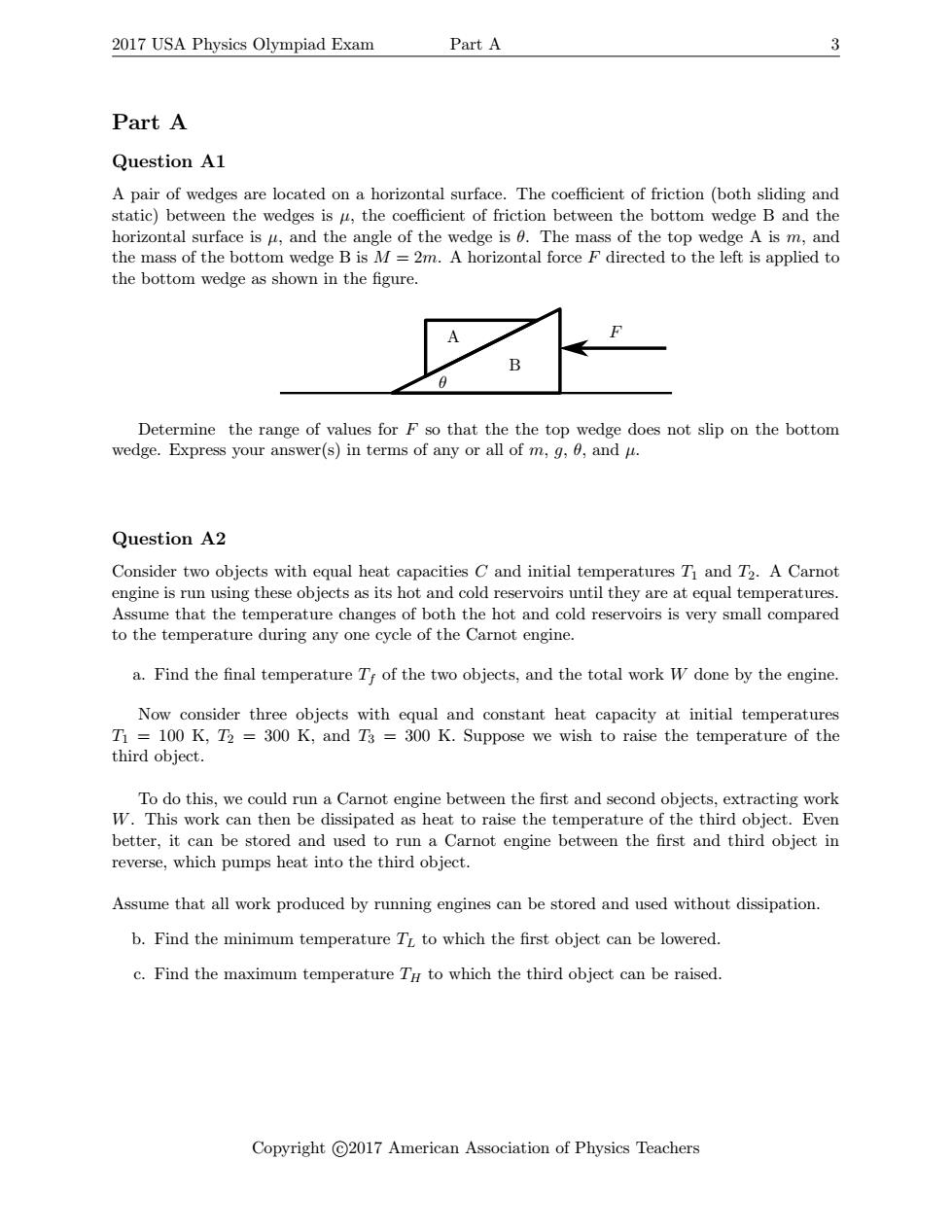正在加载图片...

2017 USA Physics Olympiad Exam Part A 3 Part A Question Al A pair of wedges are located on a horizontal surface.The coefficient of friction (both sliding and static)between the wedges is u,the coefficient of friction between the bottom wedge B and the horizontal surface is u,and the angle of the wedge is 6.The mass of the top wedge A is m,and the mass of the bottom wedge B is M=2m.A horizontal force F directed to the left is applied to the bottom wedge as shown in the figure. A B Determine the range of values for F so that the the top wedge does not slip on the bottom wedge.Express your answer(s)in terms of any or all of m,g,6,and u. Question A2 Consider two objects with equal heat capacities C and initial temperatures T1 and T2.A Carnot engine is run using these objects as its hot and cold reservoirs until they are at equal temperatures. Assume that the temperature changes of both the hot and cold reservoirs is very small compared to the temperature during any one cycle of the Carnot engine. a.Find the final temperature Tr of the two objects,and the total work W done by the engine. Now consider three objects with equal and constant heat capacity at initial temperatures Ti=100 K,T2=300 K,and T3 =300 K.Suppose we wish to raise the temperature of the third object. To do this,we could run a Carnot engine between the first and second objects,extracting work W.This work can then be dissipated as heat to raise the temperature of the third object.Even better,it can be stored and used to run a Carnot engine between the first and third object in reverse,which pumps heat into the third object. Assume that all work produced by running engines can be stored and used without dissipation. b.Find the minimum temperature TL to which the first object can be lowered. c.Find the maximum temperature Ty to which the third object can be raised. Copyright C2017 American Association of Physics Teachers2017 USA Physics Olympiad Exam Part A 3 Part A Question A1 A pair of wedges are located on a horizontal surface. The coefficient of friction (both sliding and static) between the wedges is µ, the coefficient of friction between the bottom wedge B and the horizontal surface is µ, and the angle of the wedge is θ. The mass of the top wedge A is m, and the mass of the bottom wedge B is M = 2m. A horizontal force F directed to the left is applied to the bottom wedge as shown in the figure. B A F θ Determine the range of values for F so that the the top wedge does not slip on the bottom wedge. Express your answer(s) in terms of any or all of m, g, θ, and µ. Question A2 Consider two objects with equal heat capacities C and initial temperatures T1 and T2. A Carnot engine is run using these objects as its hot and cold reservoirs until they are at equal temperatures. Assume that the temperature changes of both the hot and cold reservoirs is very small compared to the temperature during any one cycle of the Carnot engine. a. Find the final temperature Tf of the two objects, and the total work W done by the engine. Now consider three objects with equal and constant heat capacity at initial temperatures T1 = 100 K, T2 = 300 K, and T3 = 300 K. Suppose we wish to raise the temperature of the third object. To do this, we could run a Carnot engine between the first and second objects, extracting work W. This work can then be dissipated as heat to raise the temperature of the third object. Even better, it can be stored and used to run a Carnot engine between the first and third object in reverse, which pumps heat into the third object. Assume that all work produced by running engines can be stored and used without dissipation. b. Find the minimum temperature TL to which the first object can be lowered. c. Find the maximum temperature TH to which the third object can be raised. Copyright c 2017 American Association of Physics Teachers